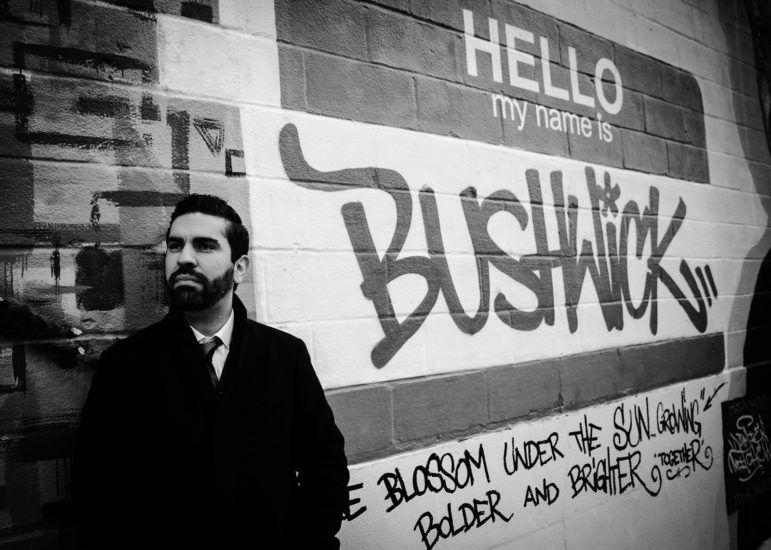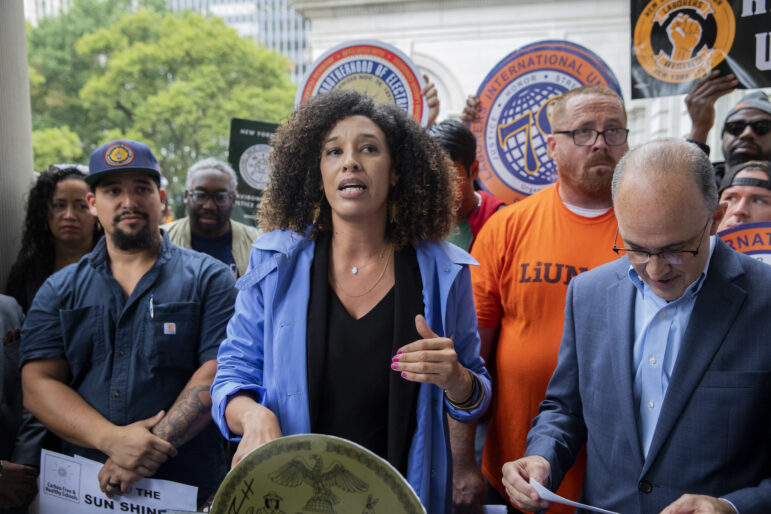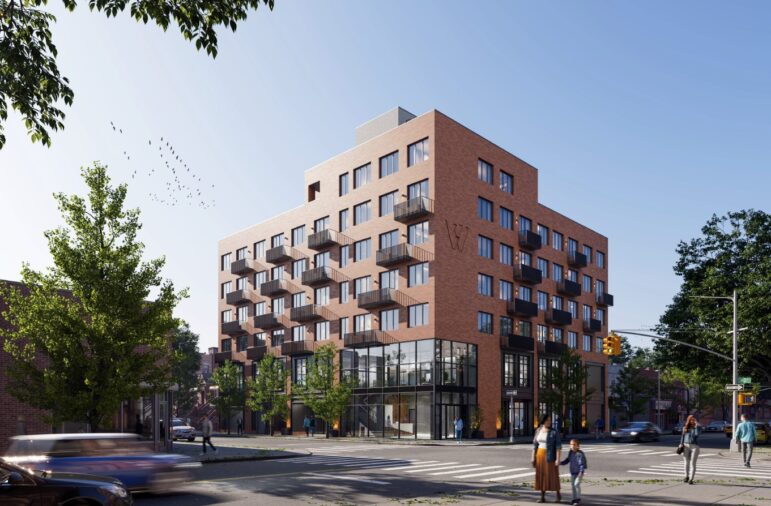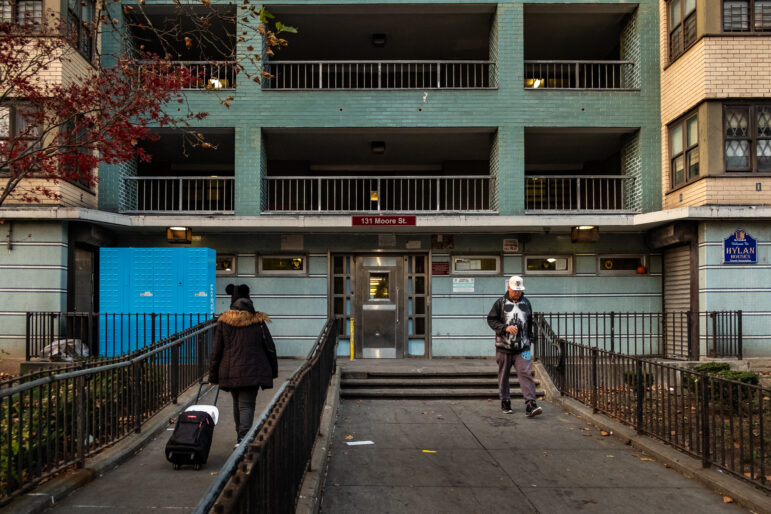
William Alatriste for the New York City Council
Rafael Espinal in a 2015 photo.
Six years ago, community leaders in Bushwick sounded an alarm: They wrote to their local Councilmembers Rafael Espinal and Antonio Reynoso expressing their concern that out-of-scale development was changing the neighborhood, increasing pressure on low-income renters and threatening its character. From that grew the Bushwick steering committee and the “Community Plan” released last year. Now the de Blasio administration has put forward its own rezoning vision. As part of its reporting project in Bushwick this summer, City Limits sat down with Espinal on July 12 to discuss those proposals and the issues facing the neighborhood. Our conversation is below (read our July 1 interview with Reynoso here):
CL: In the part of Bushwick you represent, where would you say are the most visible signs of the change that’s occurred in the neighborhood over the past decade?
RE: If you want to look at change in terms of gentrification, it’s toward the western part of Bushwick. The northwest, along the L line, is where we have seem a lot of new small businesses in terms of bars, restaurants popping up as well as new luxury units being built. In the past 10 years, I think when it started to become clear that Bushwick was going to become the next heavily gentrified neighborhood was when I saw a luxury loft building being completed on Eldert Street. That was about 10 years ago. It was a luxury building with a swimming pool, many condo units. Rents were a lot higher than in the surrounding area. When I first got to office, or first started working in government, the idea that rents in Bushwick would be $2,000 a month wasn’t real yet.
CL: Has that building had a broader effect on that area?
RE: Oh absolutely. The north part of the Eldert Street corridor became a cool little hotspot for young millennials to move into–because of the avail of this new, market-rate apartments and also because of how inexpensive it was to live in that surrounding area.
CL: If you and Antonio Reynoso achieve a rezoning close to the one the community stakeholders have requested, and it’s coupled with the recent tightening of rent regulations in Albany, would that combination allow low- and moderate-income Bushwick to survive in place?
RE: I think that it’s a recipe that will get us as close to that vision as possible. It’s a shame that this didn’t happen, you know, 10 years ago because I think that Bushwick would be a lot different. I think the reason that Bushwick has quickly gentrified is because the zoning had no real caps on the side streets or the major corridors, which allowed developers to come in, buy up foreclosed properties, take over zombie homes tear them down and build as many market-rate units as they can. Also, when it comes to displacement, the rent regs weren’t there to protect elderly tenants and tenants who were low-income and living on the margins from being able to hold on to their apartments. I believe the situation we’re in now will protect Bushwick as it is today but it’s a shame it didn’t happen earlier.
CL: One of the major sticking points between the community plan and the city plan for rezoning Bushwick is how much conversion of manufacturing space to residential use (a.k.a. M to R) will be tolerated.
RE: Just recently I approved the rezoning of a manufacturing parking-lot site, DeKalb – It was after the fact that the Bushwick community plan called for no M to R but because we were able to put the right amount of pressure on the developers and kind of told them that we’re not going to approve any rezoning that doesn’t maximize housing on this M site we were able to get 100 percent low-income affordable on that site, which is something that I think was unheard of in Bushwick to this point. That was a major victory. Not only because we got 100 percent affordable, but because we were able to show that is possible to take manufacturing sites and not to have to build luxury hosing to get affordable. The city can play a role in making subsidy investments to turn M into affordable Rs.
CL: Do you think the industrial businesses in Bushwick actually employ local residents?
RE: I can’t say that for sure in Bushwick. In the East New York IBZ, which is right next door, absolutely. We’ve had many constituents of mine, actually who are being pushed out of Bushwick and were looking for a job and I was able to get—for example, one gentleman a job in a yellow bus company. He went from being unemployed to making a good salary, and now he’s at the point where he’s looking for affordable housing.
CL: You’ve promoted a basement apartment legalization pilot in East New York. Do you see potential for that in Bushwick?
RE: We have a lot of homeowners in Bushwick, especially on the sides streets, which is why preservation and downzoning is so important. Yes, we’re protecting tenants, but we’re protecting homeowners as well. If we get the East New York basement pilot going and apply it to the rest of the city, we’re going to see thousands of homeowners in Bushwick tap into that program. I think one of the issues with the basement pilot is the zoning in East New York made it limited to certain housing stocks. We’re going to look at how we can maximize that program to serve as many homeowners as possible.
[optin-monster-shortcode id=”jrapfmitogeenlyr5x7g”]
CL: How would you characterize the differences between the mayor’s rezoning vision and the Bushwick community plan?
RE: The mayor’s office is looking to maximize housing development. Their plan currently lacks sensitivity to the need for stopping the growth of market-rate housing and looking at how we maximize affordable housing. While, yes, it calls for preservation of side streets it also looks for sign upzoning in the corridors. We have concerns about how hight they want to go. We are also concerned about a lack of commitment to looking at public sites.
CL: You’ve called recently for steps to support more urban agriculture. Do you see potential for that here?
RE: I’m personally calling for a moratorium on any development where community gardens exist in the city. There’s a good chunk of them in Bushwick
CL: Is access to food an issue here?
RE:Bushwick historically has had issues with access to fresh fruits and vegetables. There are supermarkets that exist. They are limited. One popular market is the Food Bazaar. There’s concern that … the owners of the site want to build, want to develop there. And there’s concern that we might lose that hub. That’s in talks.
CL: Access to healthcare is often cited as a problem in Bushwick, even though there is a public hospital right here. How do you see the mayor’s NYC Care initiative affecting that issue?
RE: Wyckoff Hospital has had a very volatile history. There were many instances where they were under threat of closure. The management there has been able to kind of find a way to stabilize it. I think they’re doing everything they can to stabilize their finances. I’m not sure exactly how the mayor’s vision would plug into Bushwick.
CL: Housing and development are obviously the overriding concerns in Bushwick. But what else is on your constituents’ minds?
RE: Bushwick is a very dense community. I would dare to say it’s more dense than Cypress Hills. I would say there’s a real coner about whether this rezoning will create more green space. Whether its an opportunity to redesign certain streets so we can lower air pollution. There’s also concern about the lack of community space. We have one youth center. We need to look at how we create more community centers so the youth can have somewhere to go. I think the rezoning is also an opportunity to leverage capital dollars from the mayor for that.








